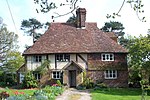Chiddingstone Castle

Chiddingstone Castle is situated in the village of Chiddingstone, near Edenbridge, Kent, England, 35 miles (56 kilometres) south-southeast of London and in the upper valley of the River Medway. The castle was built by the Streatfeild family and served as their seat from the early 16th century until the beginning of the 20th century when the family left the castle. The Streatfeilds sold the castle to Lord Astor in 1938. Since 1977, the castle and its 35 acres (14 hectares) of grounds have been held in trust for the nation by the Denys Eyre Bower Bequest, and both are open to the public. Much of the current structure dates from the early 19th century, but incorporates elements of the earlier buildings on the same site.
Excerpt from the Wikipedia article Chiddingstone Castle (License: CC BY-SA 3.0, Authors, Images).Chiddingstone Castle
Chiddingstone Road,
Geographical coordinates (GPS) Address Nearby Places Show on map
Geographical coordinates (GPS)
| Latitude | Longitude |
|---|---|
| N 51.1858 ° | E 0.1424 ° |
Address
Chiddingstone Road
TN8 7AB
England, United Kingdom
Open on Google Maps










